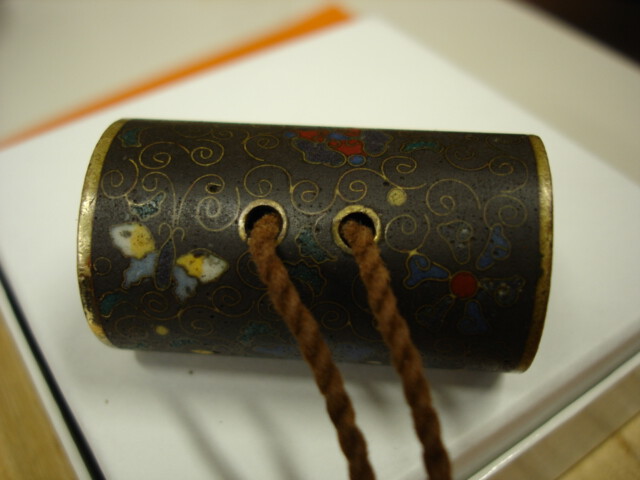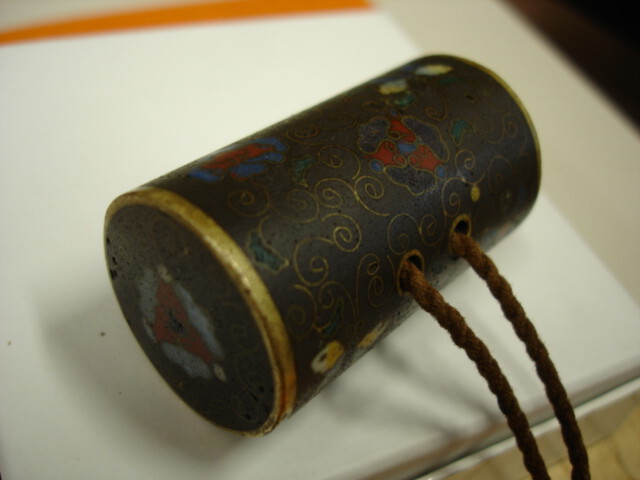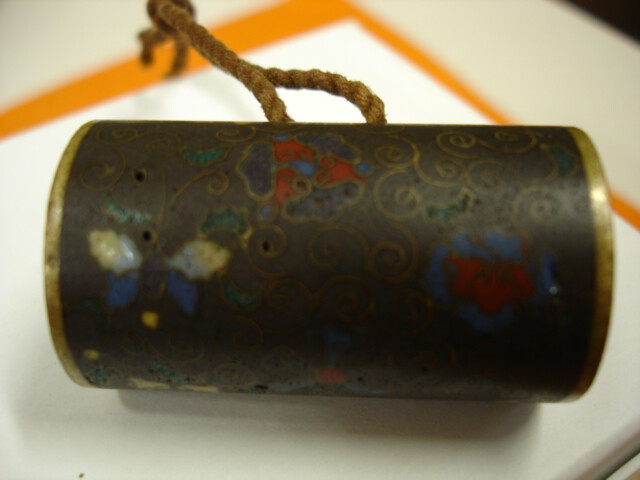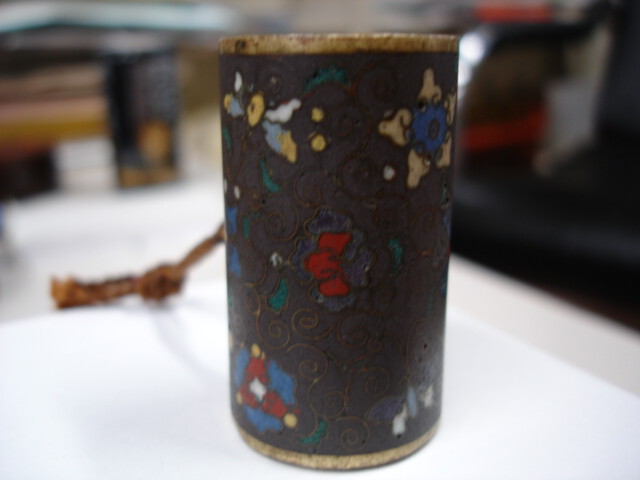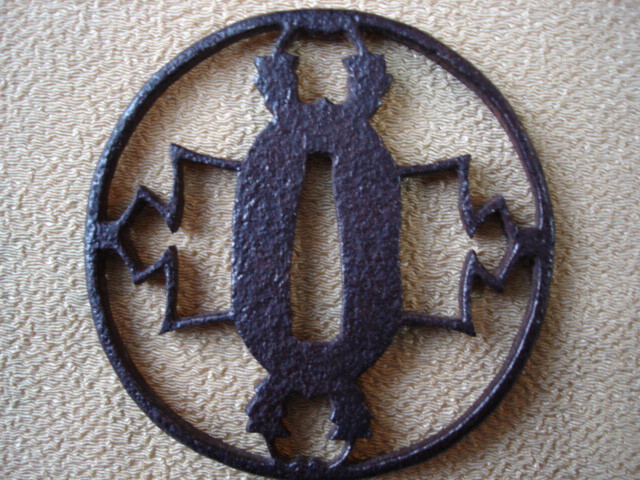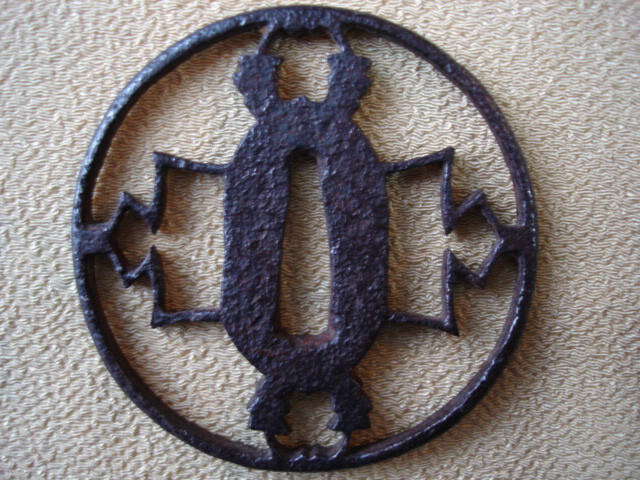-
Posts
13,144 -
Joined
-
Last visited
-
Days Won
226
Content Type
Profiles
Forums
Events
Store
Downloads
Gallery
Everything posted by Bugyotsuji
-
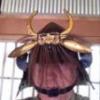
This Week's Edo Period Corner
Bugyotsuji replied to Bugyotsuji's topic in General Nihonto Related Discussion
*****Having washed some of the surface grime off with soap and water. The dealer assured me it is old, and my collector friend says he will buy it off me whenever I grow tired of it... -
Reinhard spotted the edge, and he was right, but that is a lovely tsuba there! PS Do you have the name in writing? The Hana-omodaka Mon was used by several families, not just Mizuno. It was very slightly adapted by each. The Mizuno family attached two lines of flowing water to the bottom of the Mon, and cut short the three stems to compensate. Please cross-check with your version.
-
Mmmm... nice Ageha-cho there, John. Ikeda, Tottori Castle, family connection?
-
I am amazed. How can you see that from that photograph?
-

This Week's Edo Period Corner
Bugyotsuji replied to Bugyotsuji's topic in General Nihonto Related Discussion
Ah, there's that word again! I saw it yesterday when I did a search on cloisonne. Thank you John for the pointer. Something to investigate and keep me quiet! 3 hours and a bit of sleuthing later... Right, so, Champleve' is enamel etc. being set into metal. (The Netsuke 'bead' I am looking at seems closer to mosaic glass, Venetian glass, millefiori, murrine... Into a dark background have been pushed some cut-off glass rod-ends creating the impression of occasional butterflies and flowers. If we can forgive Wikipedia: http://en.wikipedia.org/wiki/Millefiori ... Millefiori and also see the French design of Mille-fleur: http://en.wikipedia.org/wiki/Mille-fleur it betrays a somewhat similar feeling to the background of the tapestry illustrated there.) Two hours later EDIT Had a long look through a magnifying glass and discovered that everything posted above was a lie. I can see brass wires which seem to have been pushed down into the black glass background. Then it would appear that differently-coloured/colored glass or enamel has been set into the wired-off patterned sections to show butterflies and flowers. Many apologies. 七å®ç„¼ã shippou-yaki it is then. Absolutely no idea of age. -

This Week's Edo Period Corner
Bugyotsuji replied to Bugyotsuji's topic in General Nihonto Related Discussion
This week I have collected various odd things from different places. One thing I noticed was a need to buy Tsuba. Why? The only reason I could see immediately apart from wanting to own it, was to photograph it and post it on this site. This was shocking to me and I pulled on the brakes immediately. Does anyone else suffer from this desire to buy something, fed by a need to post here? Don't tell me I am the only one with this illness, please! The Tsuba I purchased on Saturday is now over in Tosogu under Bugsy's box of Tsuba. Last Sunday I found a large green cotton/linen furoshiki, filthy dirty and wanting an owner after a hundred years or so. Mon in one corner. The dealer let me have it for a trifle, and I took it home and washed it gently while having a bath. Some of the indigo and yellow dyes came out with the grime, but it now smells neutral, and the wife ironed it for me. Has a few holes and tears but could be a good furoshiki for the helmet. Then today I bought a Netsuke (from an old dealer who studiously avoids having any 'modern' repros) and now find myself wondering if someone could enlighten me. It is like a large Tombo-dama bead, cylindrical, about the shape but slightly smaller than a medium sized torch/flashlight C battery, in glass cloisonne. Decorated with flowers and butterflies, but showing no wire surrounds to the designs. Two himotoshi holes on one side with...possibly brass rims. The circular edges of the barrel ends also seem to be banded in brass? What I would like to know is whether a glass cylinder with glass motifs flush with the surface & no discernable wire motif surrounds to them should be classified as cloisonne. Is there another word I should be using? The dealer called it 七å®ç„¼ã shippo-yaki. I have been looking for cloisonne tsuba for comparison, but the only example seemed quite a different thing, being beautiful multicoloured enamel on a metal background. The enamel on the tsuba in the example looks to have been poured into a wire frame... -
I'm sorry, but it reads: SOTEN SEI reinhard Thank you for your probably correct On reading, as opposed to my literal but blind Kun reading Munenori = Soten (sei, made by) Edit. Steve, the last letter SEI means 'made this'. It doesn't mean 'made the sword'. It means 'made this particular fitment for the hilt decorations'. Sei 製 here, or often saku 作  You should be looking for the two previous characters 宗典 which should be read "So-ten" according to Reinhard. Judging by the nature of Reinhard's field, and the tone of his voice, I would say that he is the man to ask. :lol:
-

ARMS AND ARMOR OF ANCIENT JAPAN - Link
Bugyotsuji replied to Brian's topic in General Nihonto Related Discussion
Great link, Brian. Looks like some good stuff in there. -
"Various theories about 金基, that he was the 2nd gen Kanemoto 兼元 's father, younger brother, the same person, or disciple. Possibly he was a younger brother. Jozu de aru."
-
The furnishings were often changed around, Steve, so the age of a blade is literally that, the blade and Nakago (tang) itself. No judgement on the age can be made from most of those piccies! We would need to see photographs of the whole blade, and some close-ups of each of its constituent parts before the guessing/narrowing can begin. Your signature on the fuchi reads, Munenori, BTW.
-
One intriguing story is that the Shogunate could not subdue the rebels in the castle of Shimabara as it was virtually impregnable. With the right ships and armaments they felt sure they could bombard the defenders into surrender, so they decided to test the Dutch desire to remain sole traders at Dejima in Nagasaki. "Lend us your ships and guns to attack the Catholics and at the same time prove that Protestants are not a threat to Japan." And the rest is another twist of history...
-
Not sure what you are asking, but moto can be expressed today as 本, moto, or in an older form, 基 moto. :|
-
Well, I found a wakizashi tsuba today and will add it to the box of tsuba once I've cloth-rubbed it a bit more. So far I think it is ... but that's the limit of my knowledge. Iron, Mumei, thickness at mimi. 0.25, height & width 6.5 mm. Edit. Talking to a couple of people and was told: "This kind of tsuba was made throughout Japan, so no, you will not be able to pin it down to one locality. It was a really tough job to file out that pattern by hand." Looking at these two photos again in the clarity of a new day, I can now distinguish the front and the back more easily. Two of the corner spaces are larger. I can fit my finger through them, so although there is a nice symmetry to the tusba, it is very slightly weighted. Just had a deep :lol: thought. What does this tsuba tell us? This tsuba has left the forum members speechless. Perhaps the Japanese like/liked feeling speechless, whereas Westerners like to be triggered into talking. Or are we all the same fundamentally? Everyone likes a talking point?
-
Congrats Anthony. A lovely looking yari!
-
My imagination is playing with those 4 symbols and hidden meanings. The word Christian was pronounced Ki-ri-shi-tan, in 4 syllables. The last two, shi and tan, could be symbolized by the shiitake and hyoutan. Could the first two be expressed in some way that the represent Ki and Ri? Ku for Kumo might at a stretch give Ku of Kurusu or cross. Kiri is mist... (Kuristo = Kirisuto) But what words are there to express lantern? "Bon-bori".............?
-
Tsuba in general are roundish, just about exactly the right size to protect the clenched fist 360 degrees from a sword cut. It struck me that the cross-shaped tsuba above would not offer that protection.
-
Some good horse sense... I like it. :lol: An eternal conundrum for the smith. How to get it right, how to find the perfect balance? Reputation being everything. Appease the gods, keep your eyes and ears open for battlefield feedback, then rely on your craftsmen forebears, and your own life force, wit & skill.
-
First of all, apologies again to Barry! Sorry! No, I did not suspect you of commercial motives at all. It was simply the lack of environment and context that seemed to be holding people back from breaking the ice. Over 50 people had looked and passed when I took the first little exploratory step!
-
Thank you for the interesting explanation of the katakana 'kanji', Morita san! Were there other kanji created like this, I wonder? Barry, please forgive my directness. One of the problems with the translation section is lack of background information and supporting clues, not necessarily photographs, which puts extra strain on anyone trying to help. I have mentioned this several times before in the last few weeks, but perhaps I am over sensitive, with too thin a skin??? Morita san, what do you think the inscription means? That this blade is certified 'able to cut down both men and horses'? PS Is it just me or does anyone else get the feeling that the inscriptions were cut after the Nakago ana?
-
Barry, you are asking this with no background information! This severely limits any information anyone might be willing to offer. Nobody (Moriyama san) has been very brave in giving you so much, IMHO. The Nakago looks very 'new' to me, and I wonder why there would be not one but two Nakago-ana, both with the same colour inside. What is this, and why are you asking? PS A question to Moriyama san. What is the character between 人馬 and 切�
-
Mitsumoto on one side, and Naito on the other
-
Now there's a man with an angle! You lost me in the first sentence with the word 'ductile', which I had to go and look up. What you have said has moved the game forward. Thank you very much for your observations, Alan. Would it be true to say then, that the maker of a long thin spear blade would, in an ideal world, want the point to be a perfect mix of hardness and toughness, but might slightly prefer the point to bend or contract somewhat on the battlefield (rather than snap), as it can always be hammered out to some extent for emergency re-use?
-
Nagasa? It's at the shop. Will collect it tomorrow and measure the blade length. It's short enough not to need a toroku-sho, about 12 or 13 cm from memory, but it's ryo-shinogi which is expensive...
-
Jean, you are a true diplomat! Don't forget this was without any overall polishing. Answer. Thinking this was quite reasonable, I took him a different fukuro-yari spear on Monday which was half polished. About 18 months ago I had paid 25,000 yen for a togi, thinking I would get a super good deal.... big mistake. The guy had painted the saya and sleeve black, and after getting most of the rust off, coated the blade in some kind of clear lacquer. What a mess! So, having already spent 25,000 I didn't expect to have to pay too much more. To clean the other fukuro yari and make it perfect the togishi is now asking .


